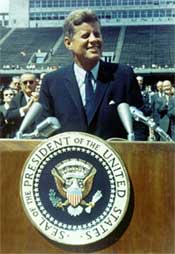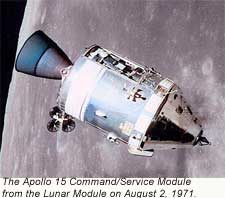Project Apollo was a series of human spaceflight missions undertaken by the United States of America using the Apollo spacecraft, conducted during the years 1961-1972. It was devoted to the goal of landing a man on the Moon and returning him safely to Earth within the decade of the 1960s. This goal was achieved with the Apollo 11 mission in 1969. The program continued into the early 1970s to carry out the initial hands-on scientific exploration of the Moon. As of 2005, there has not been any further human spaceflight beyond low earth orbit.

 Having settled upon the Moon as a target, the Apollo mission planners were faced with the challenge of designing a flight plan attaining Kennedy's stated goal while minimizing risk to human life, cost and demands on technology and astronaut skill. Having settled upon the Moon as a target, the Apollo mission planners were faced with the challenge of designing a flight plan attaining Kennedy's stated goal while minimizing risk to human life, cost and demands on technology and astronaut skill.
In contrast with the other plans, the LOR (Lunar orbit rendezvous) plan required only a small part of the spacecraft to land on the moon, thereby minimizing the mass to be launched from the moon's surface for the return trip.
The Lunar Module itself was composed of a descent stage and an ascent stage, the former serving as a launch platform for the latter when the lunar exploration party blasted off for lunar orbit. To learn lunar landing techniques, astronauts practiced in the Lunar Landing Research Vehicle (LLRV), a flying vehicle that simulated the Lunar Module on earth.
 The Apollo program included eleven manned flights, designated Apollo 7 through Apollo 17, all launched from the Kennedy Space Center, Florida. Apollo 4 through Apollo 6 were unmanned test flights (officially there was no Apollo 2 or Apollo 3); the Apollo 1 designation was retroactively applied to the originally planned first manned flight which ended in a disastrous fire during a launch pad test that killed three astronauts. The Apollo program included eleven manned flights, designated Apollo 7 through Apollo 17, all launched from the Kennedy Space Center, Florida. Apollo 4 through Apollo 6 were unmanned test flights (officially there was no Apollo 2 or Apollo 3); the Apollo 1 designation was retroactively applied to the originally planned first manned flight which ended in a disastrous fire during a launch pad test that killed three astronauts.

 Neil Alden Armstrong (born August 5, 1930) is a former American astronaut, test pilot, university professor, and Naval Aviator. Armstrong was the first human to set foot on the Moon and was the first human to ever step on an extraterrestrial world. His first spaceflight was Gemini 8 in 1966, for which he was the command pilot. On this mission, he performed the first manned docking of two spacecraft together with pilot David Scott. Armstrong's second and last spaceflight was as mission commander of the Apollo 11 moon-landing mission on July 20, 1969. On this famous "giant leap for mankind," Armstrong and Buzz Aldrin descended to the lunar surface and spent 2.5 hours exploring while Michael Collins orbited above. Neil Alden Armstrong (born August 5, 1930) is a former American astronaut, test pilot, university professor, and Naval Aviator. Armstrong was the first human to set foot on the Moon and was the first human to ever step on an extraterrestrial world. His first spaceflight was Gemini 8 in 1966, for which he was the command pilot. On this mission, he performed the first manned docking of two spacecraft together with pilot David Scott. Armstrong's second and last spaceflight was as mission commander of the Apollo 11 moon-landing mission on July 20, 1969. On this famous "giant leap for mankind," Armstrong and Buzz Aldrin descended to the lunar surface and spent 2.5 hours exploring while Michael Collins orbited above.
Colonel Buzz Aldrin, Sc.D (born January 20, 1930) is an American pilot and astronaut who was the Lunar Module Pilot on Apollo 11, the first lunar landing. He became the second person to set foot on the Moon (after Mission Commander Neil Armstrong).
|